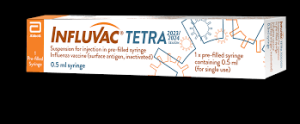Influenza, commonly known as the flu, is a contagious respiratory illness that affects millions of people worldwide each year. Vaccination remains the most effective way to prevent the flu and its complications. One of the widely used flu vaccines is Influvac. Designed to protect against the most common and severe strains of the influenza virus, Influvac is a trusted choice for individuals looking to safeguard their health during flu season. In this comprehensive guide, we will explore what Influvac is, how it works, its benefits, potential side effects, and why getting vaccinated is more important than ever.
What is Influvac?
Influvac is an inactivated influenza vaccine, which means it contains killed virus particles that cannot cause the flu. This vaccine is specifically formulated each year to match the circulating influenza strains identified by global health authorities, including the World Health Organization (WHO). Influvac is available in different formulations, including standard-dose and quadrivalent versions, designed to protect against multiple influenza virus strains, typically two A strains (H1N1 and H3N2) and two B strains.
The vaccine works by stimulating the body’s immune system to produce antibodies against the virus, providing immunity if exposed to the live virus in the future. Influvac is suitable for adults, including the elderly, and some formulations are approved for children as young as six months.

How Does Influvac Work?
Influvac works by introducing inactivated (killed) virus particles into the body. These particles are not capable of causing illness but are sufficient to stimulate the immune system to produce antibodies. Here’s a closer look at how the process works:
- Immune Response Activation
Once the vaccine is administered, usually via an intramuscular injection in the upper arm, the immune system recognizes the inactivated virus particles as foreign invaders. This triggers an immune response, leading to the production of antibodies specifically designed to target the influenza virus.
- Antibody Production
The antibodies produced in response to the vaccine remain in the body, providing immunity against the specific strains included in the vaccine formulation. If the vaccinated individual is later exposed to the live virus, the immune system is primed to recognize and attack the virus quickly, preventing illness or significantly reducing the severity of symptoms.
- Protection Against Multiple Strains
Influvac is updated annually to include the most current influenza strains identified by global surveillance. This ensures that the vaccine provides the best possible protection against the flu each season. The quadrivalent version of Influvac offers broader protection by targeting four different strains, making it a popular choice during flu season.
Benefits of Getting the Influvac Vaccine
Getting vaccinated with Influvac offers numerous benefits, not just for individual health but also for public health. Here are the key reasons why Influvac is a valuable tool in preventing influenza:
- Prevents Influenza Infection
The primary benefit of Influvac is that it helps prevent influenza infection. Even though no vaccine offers 100% protection, Influvac significantly reduces the risk of getting the flu. In the event that a vaccinated individual contracts the flu, symptoms are usually milder, and the duration of the illness is shorter.
- Reduces Severe Outcomes and Hospitalizations
Influenza can lead to severe complications, especially in vulnerable populations such as the elderly, young children, pregnant women, and individuals with chronic health conditions. Complications can include pneumonia, bronchitis, and worsening of existing medical conditions. Influvac helps reduce the risk of these severe outcomes and lowers the likelihood of hospitalization due to flu-related complications.
- Protects High-Risk Populations
Influvac plays a critical role in protecting high-risk groups who are more susceptible to severe flu-related complications. Vaccination helps build herd immunity, indirectly protecting those who cannot get vaccinated, such as infants under six months and individuals with certain medical conditions.
- Prevents Spread of Influenza in the Community
Getting vaccinated doesn’t just protect you—it also protects your loved ones and the wider community. Influvac helps reduce the transmission of the flu virus, lowering the overall burden of the disease on society. This is particularly important in communal settings such as schools, workplaces, and nursing homes.
- Supports Public Health Efforts
Widespread vaccination helps ease the strain on healthcare systems, especially during peak flu season when hospital resources can be stretched thin. By reducing the number of flu cases, Influvac helps healthcare providers focus on patients with more critical conditions.
Who Should Get Influvac?
Influvac is recommended for most people aged six months and older, but it is particularly important for the following groups:
- Older Adults (65+): Seniors are at higher risk of severe flu complications, making vaccination essential.
- People with Chronic Health Conditions: Individuals with heart disease, diabetes, asthma, or weakened immune systems should get vaccinated to reduce the risk of severe illness.
- Pregnant Women: Vaccination during pregnancy protects both the mother and the newborn, who benefits from the mother’s antibodies.
- Healthcare Workers: Those working in healthcare settings are at a higher risk of exposure and should be vaccinated to protect themselves and their patients.
- Children: Children aged six months and older are recommended to get the flu vaccine, as they are highly susceptible to influenza and its complications.
Potential Side Effects of Influvac
Like all vaccines, Influvac can cause side effects, although most are mild and resolve on their own. Understanding the potential side effects can help individuals make informed decisions about vaccination. Common side effects include:
- Pain and Swelling at the Injection Site
It’s common to experience mild pain, redness, or swelling where the vaccine was administered. This reaction is typically short-lived and usually resolves within a few days.
- Mild Fever and Fatigue
Some individuals may develop a low-grade fever, headache, or feel slightly fatigued after receiving Influvac. These symptoms are usually mild and are signs that the body is building immunity.
- Muscle Aches
Mild muscle aches and joint pain can occur following the vaccination. These symptoms are generally short-lived and manageable with over-the-counter pain relievers.
- Allergic Reactions (Rare)
Severe allergic reactions to Influvac are extremely rare. Symptoms of an allergic reaction, such as hives, difficulty breathing, or swelling of the face and throat, require immediate medical attention. Individuals with a history of severe allergic reactions to any component of the vaccine should consult their healthcare provider before vaccination.
Debunking Common Myths About Influvac
Despite the proven benefits of Influvac, several myths and misconceptions persist, discouraging some people from getting vaccinated. Let’s address some of the most common myths:
- Myth: “The Flu Vaccine Can Give You the Flu.”
Fact: Influvac contains inactivated virus particles that cannot cause the flu. Any flu-like symptoms experienced after vaccination are usually mild side effects and not an indication of infection.
- Myth: “I Don’t Need the Flu Vaccine if I’m Healthy.”
Fact: Even healthy individuals can contract the flu and experience severe symptoms. Vaccination helps protect you and those around you, including vulnerable populations.
- Myth: “The Flu Vaccine Isn’t Effective.”
Fact: While the effectiveness of the flu vaccine can vary, it significantly reduces the risk of infection and lessens the severity of the illness if you do contract the flu.
- Myth: “I Got the Flu Vaccine Last Year; I Don’t Need It Again.”
Fact: The influenza virus mutates rapidly, and vaccine formulations are updated annually to match the circulating strains. Yearly vaccination is necessary for optimal protection.
Best Practices for Influvac Vaccination
To maximize the effectiveness of Influvac, it’s important to follow best practices:
- Get Vaccinated Early in the Season
The best time to get vaccinated is before the flu season begins, ideally in the fall. This allows your body time to develop immunity before the virus starts circulating widely.
- Consult Your Healthcare Provider
If you have any concerns about the vaccine, consult your healthcare provider for personalized advice. They can provide guidance based on your health history and specific needs.
- Monitor for Side Effects
While side effects are generally mild, monitor for any unusual reactions following vaccination. If you experience any severe or prolonged symptoms, contact your healthcare provider.
- Encourage Others to Get Vaccinated
Spread the word about the importance of flu vaccination. Encouraging family, friends, and coworkers to get vaccinated helps build community immunity and reduces the spread of influenza.
Conclusion
Influvac is a powerful tool in the fight against influenza, offering protection against the most common and severe strains of the virus. By getting vaccinated, you protect not only yourself but also those around you, contributing to a healthier and safer community. As flu season approaches, make sure to get your Influvac shot and encourage others to do the same. Remember, vaccination is one of the most effective ways to prevent influenza and its complications, keeping you and your loved ones healthy throughout the year.


